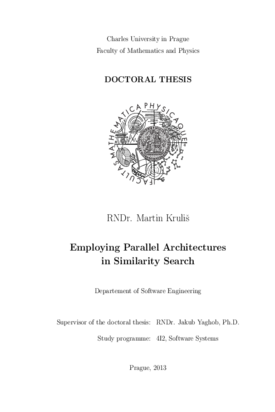Employing Parallel Architectures in Similarity Search
Nasazení paralelních architektur v podrobnostním vyhledávání
dizertační práce (OBHÁJENO)

Zobrazit/
Trvalý odkaz
http://hdl.handle.net/20.500.11956/60001Identifikátory
SIS: 70643
Kolekce
- Kvalifikační práce [10690]
Autor
Vedoucí práce
Oponent práce
Platoš, Jan
Pllana, Sabri
Fakulta / součást
Matematicko-fyzikální fakulta
Obor
Softwarové systémy
Katedra / ústav / klinika
Katedra softwarového inženýrství
Datum obhajoby
10. 6. 2013
Nakladatel
Univerzita Karlova, Matematicko-fyzikální fakultaJazyk
Angličtina
Známka
Prospěl/a
Klíčová slova (česky)
paralelní, databáze, plánování, GPGPU, podobnostní vyhledáváníKlíčová slova (anglicky)
parallel, databases, scheduling, GPGPU, similarity searchTato práce se zabývá možnostmi nasazení masivně paralelních architektur v data- bázových systémech využívajících podobnostní vyhledávání. Hlavním předmětem našeho zájmu je využití výpočetní síly současné generace grafických karet pro vyhledávání v databázích obrázků. I přes významný pokrok v posledních letech zůstává oblast podobnostního vyhledávání velmi výpočetně náročná, takže je možné tyto metody aplikovat pouze u databází menšího rozsahu. Grafické čipy disponují obrovskou výpočetní silou, avšak jejich použitelnost pro konkrétní problémy bývá komplikovaná z důvodu specifických vlastností této architektury, které si vyžadují individuální úpravu existujících algoritmů a datových struktur. Zabývali jsme se všemi aspekty této problematiky, od efektivního využití grafických čipů pro obecné výpočty přes akceleraci vyhledávacího procesu až po efektivní indexaci obrázků. Ve většině případů přineslo nasazení grafických karet zrychlení přibližně o dva řády ve srovnání s jednojádrovými procesory a několikanásobné zrychlení ve srovnání s běžnými víceprocesorovými NUMA servery. Tato práce shrnuje naše poznatky z několikaletého výzkumu, algoritmy upravené pro specifické podmínky masivně paralelních čipů, ale také výsledky provedených experimentů, které potvrzují naše závěry.
This work examines the possibilities of employing highly parallel architectures in database systems, which are based on the similarity search paradigm. The main objective of our research is utilizing the computational power of current GPU devices for similarity search in the databases of images. Despite leaping progress made in the past few years, the similarity search problems remain very expensive from a compu- tational point of view, which limits the scope of their applicability. GPU devices have a tremendous computational power at their disposal; however, the usability of this power for particular problems is often complicated due to the specific properties of this architecture. Therefore, the existing algorithms and data structures require extensive modifications if they are to be adapted for the GPUs. We have addressed all the aspects of this domain, such as efficient utilization of the GPU hardware for generic computations, parallelization of similarity search process, and acceleration of image indexing techniques. In most cases, employing the GPU devices brought a speedup of two orders of magnitude with respect to single-core CPUs and approximately one order of magnitude with respect to multiprocessor NUMA servers. This thesis summarizes our experience and discoveries from several years of research,...
